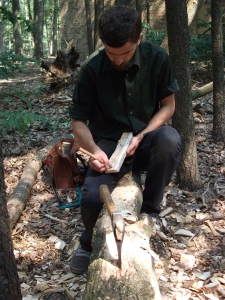I was lucky to find Anthony Wilder, the brains behind Wilder Woodworking. His method of creating spoons takes us back to a time when woodworkers made art and put love into each piece. My studio is full of hand whittled spoons made by Anthony and I'm slowly introducing them onto the website (follow this link to find them). Each one is unique and has a personality of its own. I asked Anthony to give me a description of his process which you can also find on his BLOG.
"In my opinion, the wood chipper is the grand daddy of all wood waste and it was nice to liberate some of the wood. I especially appreciated the cherry I don’t get to work in green cherry nearly enough. I have been carving a lot of spoons from it and it is a joy to work with. Spoon carving is best done green, shortly after the tree is cut. I enjoy taking the tree in its original state and taking it down to its final form.
I have been carving spoons for a few years now and it is a very pleasant pastime. Swedish style spoons are my favorite. I appreciate the genius in the design and the connection with traditional techniques and styles. A proper spoon will be higher in the handle than at the bowl. This is where I start, carving that swooping profile. Next, I draw the outline for the bowl and handle and follow those lines chopping out the waste with a hatchet. The hatchet and knives I use are hand forged by my close friend Nate Runals. (naterunals.com)"
The next step for me is to carve out the bowl. This is done with a hook knife, moving across the grain. This is very enjoyable work; a sharp hook knife will carve effortlessly through green wood.
Once the bowl is carved, I pick up my axe for some more shaping. I have learned over the years to rely more on the hatchet than the knife when carving spoons, This creates greater risk but saves precious time when doing lots of spoons. Its better to put all the risk at the beginning of the project when less time is invested and spoon carving is no exception.
Next comes the knife work. There are several techniques for this, but the goal is always to remove all of the wood that is not necessary for the form or function. I keep the knife blade skewed at all times to create easy and refined cuts that leave the surface looking polished.
After I finish the knife work I coat the spoons in walnut oil, a favorite food safe oil finish of mine. Walnut oil is available at most health food stores and gives a protective satin finish. Other good oils are natural flax oil, coconut oil, or if those are not available mineral oil will work in a pinch."
-Anthony Wilder
Wilder Woodworking












Leave a comment (all fields required)